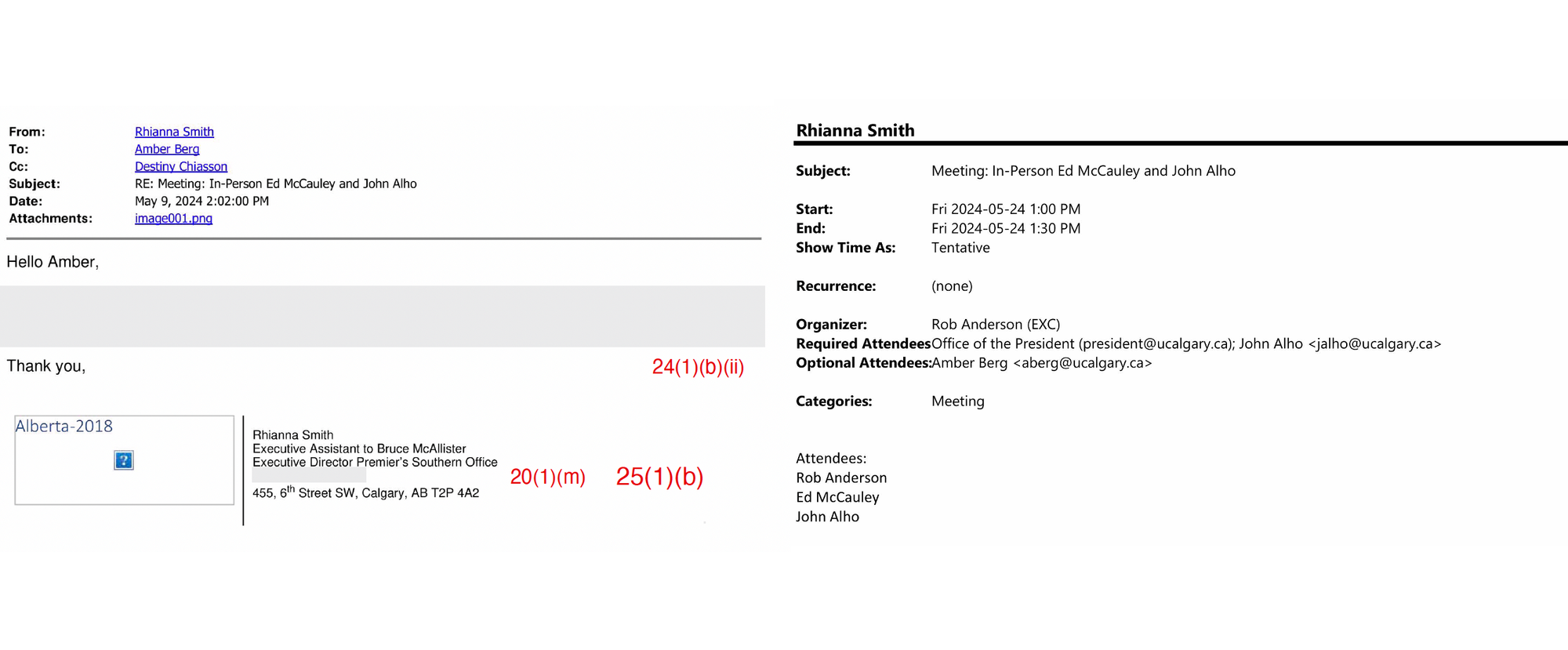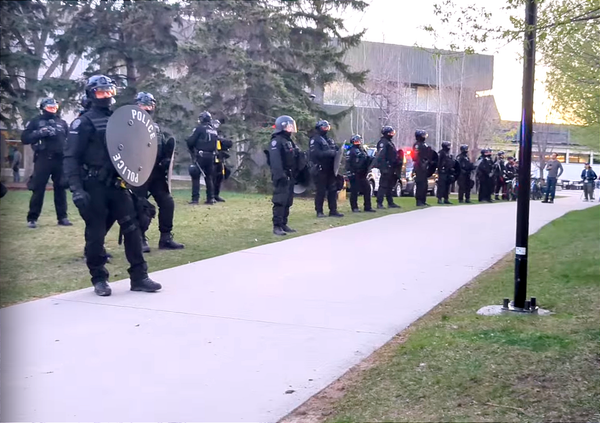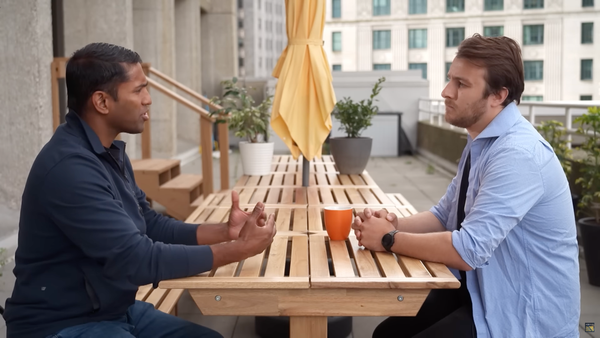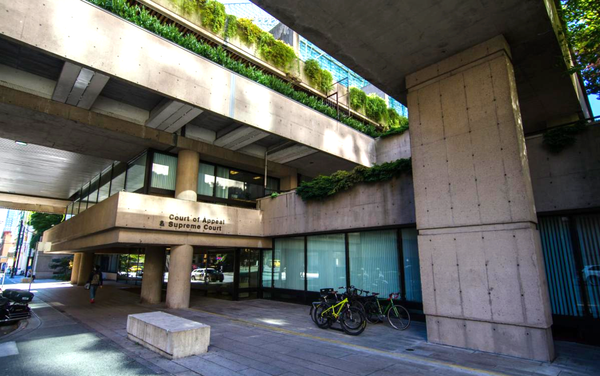Alberta's fiefdom of information
The Premier's office was in contact with the University of Calgary President's office during the peaceful May 9 Palestine solidarity demonstration. But after months of work, the events surrounding the violent deployment of riot police remain shrouded in secrecy.
!["Dear Paul ... [redacted] ... Thanks, Evan"](/content/images/size/w1200/2024/09/PXL_20240918_131849751-2.jpg)
On May 9, I was beaten and arrested by Calgary Police at the University of Calgary for attending and remaining at a protest in solidarity with Palestinians being massacred in their homes. This was detailed in May and June.
I have spent much of the summer working to reconstruct the violence that gave rise to my concussion and sprained finger, through a series of freedom of information requests to the Alberta government, Calgary Police and the University of Calgary, as well as a disclosure request concerning the Trespass ticket issued to me by Calgary Police.
Every door I have attempted to pry open for information about my beating and arrest has been locked shut, forcing me to submit a series of Privacy Commissioner complaints. But this isn't good enough – processing of these complaints takes close to a year to get started.
The public value of helping people understand the desperate state of secrecy in the province – even where personal information is concerned – holds more weight than the strategic value of keeping it under my hat.
Door #1: Calgary Police
Almost immediately after the May 9 events, I submitted three freedom of information requests to Calgary Police: for bodycam footage, for badge numbers of officers deployed, and for communications between Calgary Police and University executive.
The first two were quickly thrown out by Calgary Police, who told me since my ticket was an active case, I could not access the information through the FOIP process – this would have to take place through the Disclosure process related to my legal proceedings.
The request for communications between Calgary Police and the University, which took a full month to acknowledge, is now three months overdue.
On June 24, I received an anonymous tip and submitted another request for meeting minutes between Calgary Police and Campus Security on the morning of May 9. That request was "lost" by the Calgary Police FOIP office, so I resubmitted it on July 24. This second request remains unacknowledged by Calgary Police, despite multiple nudges to the FOIP office.
At the May 2024 Calgary Police Commission meeting, the Chief and Legal Services revealed to the Commission that it would likely take "at least 18 months" to begin relieving its freedom of information backlog.
Door #2: University of Calgary
The University of Calgary FOIP office was instructed through a lawyer's letter early on to retain all CCTV footage concerning the May 9 events. On August 26, the University received my request for the footage of my arrest and beating by Calgary Police. Within a day, the release of the footage was denied in full by the University FOIP office on the basis that it would be an invasion of privacy to share it with me, and it would be impossible to render it otherwise. I made multiple compromises in appealing this with the Office, but the Office held fast to its refusal.
Door #3: Alberta Serious Incident Response Team (Ministry of Justice)
In June, I joined others in submitting Professional Standards complaints to the Calgary Police. This was escalated to the Alberta Serious Incident Response Team (ASIRT), with a report provided by Calgary Police summarizing the initial findings.
I submitted a FOIP for that report through the Ministry of Justice. They released the information I had provided to Calgary Police but withheld several pages that I suspect contain images depicting the use of force by the police. Their basis for withholding that information was Section 21(1)(a), "disclosure harmful to intergovernmental relations."
On appeal, the Ministry FOIP office informed me that they are not authorized to provide the report because it belongs to Calgary Police. They instructed me to request the report from Calgary Police, which I did immediately. This request was acknowledged, and it will be overdue on September 23.

ASIRT has repeatedly delayed making a decision on whether it will pursue this case. My contact at ASIRT has hinted that the injuries sustained (including concussions, a sprain and a fractured rib) were not serious enough to merit ASIRT investigation, but more than two months into these conversations, no decision has been made.
Door #4: Disclosure
While I'm no stranger to public bodies refusing information through obscure FOIP subsections, my legal disclosure package seemed certain to provide useful contents. Anyone charged with an offence is entitled to see the evidence brought against them – video footage, witness information, police notes, and so on.
For the sake of the ongoing legal proceeding, I'll spare the details, but the short version is that I was provided with a tiny fraction of what I requested. My next court date is October 3.
Door #5: Provincial Government
To understand whether the Alberta government influenced the University in the decision to unleash a riot squad on a peaceful assembly, I requested correspondence between the Premier's office and the University President's office between May 9 and May 10.
This revealed that the two offices were in direct contact on May 9. At 2PM that day, six hours before the riot squad arrived on University grounds, the Premier's office set a May 24 in-person visit with the University President and Vice President Government Relations. The text of the email from the Premier's office was redacted under Section 24(1)(b)(ii), "consultations or deliberations involving a member of the Executive Council" – in this case, the Premier.

On May 10, the day after the peaceful demonstration was violently dismantled, the Premier was quoted as saying “I’m glad that the University of Calgary made the decision that they did... I’ll watch and see what the University of Alberta learns from what they observed in Calgary."
Early the next morning, riot police stormed the University of Alberta encampment, with similar injuries and arrests to show for it.
I am acutely aware that the provincial government is monitoring my activities, as I obtained 190 pages detailing my surveillance by the Ministry of Mental Health and Addiction. Much of it was redacted.
Keeping in mind this is information directly concerning me, some of the redactions in the 190 pages were entirely absurd, such as this email from the Deputy Minister:

Morbidly amused by this perversion of privacy law, a friend turned the exchange into a t-shirt:

Note: an early version of this article stated in the third-final paragraph that the Ministry of Mental Health and Addiction withheld some information under Section 29 – information that would be released to the public within 60 days. The article stated that the lack of disclosure, having passed the 60-day mark, placed the Ministry in breach of the FOIP Act. This was incorrect, as the information was provided as an attachment to the initial FOIP release. Drug Data Decoded regrets the inaccurate statement.
Drug Data Decoded provides analysis on topics related to prohibitionist drug policy using news sources, publicly available data sets and freedom of information submissions, from which the author draws reasonable opinions. The author is not a journalist.





